5 Description of the Parishes
5.1 History
A volunteer from each parish has written a short history of their own village. These have been combined into the summary below.
Our three villages are similar geographically. We share water meadows, heath land, fertile fields and dry sandy areas. Early settlements grew up close to our then navigable rivers, The Lark and The Fynn. Barrows and other archaeological finds date from the Bronze Age (1700 BC) and Iron Age. Roman artefacts have been found but it is the extent of Anglo Saxon artefacts that indicate the origin of the three parishes. This is confirmed by the Domesday survey of 1086, although in Little Bealings there is also reference to Danish invaders.
The names of our villages have changed over the years. In the Domesday Book Playford appears as Plegeforda - old English for "the ford where sports were held". Only recently the deserted village of Nekemere (the Domesday 'Necchmar') was discovered, close to Lux Farm. The earliest recorded name for Little Bealings was Parva Belinges which is thought to be derived from the old English words for a glade or piece of dry land in marshy countryside. Great Bealings is believed to be of Saxon origin, meaning the area where the Beda or Bela people lived. It was known as Belinges Magna until 1674 when the current spelling appeared, although Magna remained until much more recently.
5.1.1 The Churches
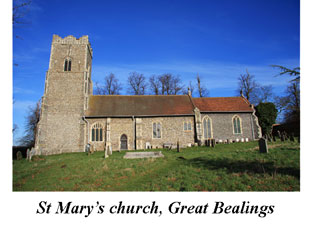 Great
Bealings The village is geographically split into two areas, with
the church set in isolation above the water meadows and marshland. The
church has some remnants from the 13th century, but is mainly 14th and
15th century including the tower with its flushwork decoration. Inside
there are monuments to John Clench and Thomas Seckford amongst others.
Seckford was born in Woodbridge in 1515 and was a senior member of the
court of Queen Elizabeth I. He also founded seven almshouses in Woodbridge.
John Clench was the son of the great Elizabethan Judge John Clench, and
died in Great Bealings in 1628. Canon Moore (son of Edward Moore of Bealings
House) was rector for forty years and was responsible for the restoration
of the church in 1842 -1851 making it much as we know it today. Pew ends
were then carved by Henry Ringham and were so well done that many people
think they are 15th century. Stained glass includes a west window by H.Hughes
(1879), a chancel south window by Mayer of Munich (1886) and a chancel
north window by Ward & Hughes (1882). The pulpit is Jacobean with
back panel and tester. The North door has tracery and three small figures
(a rarity).
Great
Bealings The village is geographically split into two areas, with
the church set in isolation above the water meadows and marshland. The
church has some remnants from the 13th century, but is mainly 14th and
15th century including the tower with its flushwork decoration. Inside
there are monuments to John Clench and Thomas Seckford amongst others.
Seckford was born in Woodbridge in 1515 and was a senior member of the
court of Queen Elizabeth I. He also founded seven almshouses in Woodbridge.
John Clench was the son of the great Elizabethan Judge John Clench, and
died in Great Bealings in 1628. Canon Moore (son of Edward Moore of Bealings
House) was rector for forty years and was responsible for the restoration
of the church in 1842 -1851 making it much as we know it today. Pew ends
were then carved by Henry Ringham and were so well done that many people
think they are 15th century. Stained glass includes a west window by H.Hughes
(1879), a chancel south window by Mayer of Munich (1886) and a chancel
north window by Ward & Hughes (1882). The pulpit is Jacobean with
back panel and tester. The North door has tracery and three small figures
(a rarity).
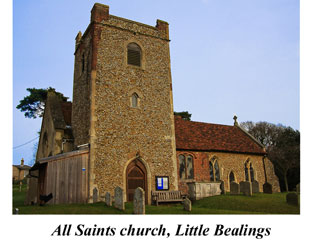 Little
Bealings The village church of All Saints was established and built,
possibly on the site of an older building, at the end of the 13th century.
The Bishop of Norwich installed the first rector in 1296. This early church
consisted of the chancel and small nave. The tower and the porch were
built later in the 15th century. The north aisle was added in the middle
of the 19th century. The font, made in the 15th century, was badly mutilated
sometime in the 1640s during the Commonwealth period.
Little
Bealings The village church of All Saints was established and built,
possibly on the site of an older building, at the end of the 13th century.
The Bishop of Norwich installed the first rector in 1296. This early church
consisted of the chancel and small nave. The tower and the porch were
built later in the 15th century. The north aisle was added in the middle
of the 19th century. The font, made in the 15th century, was badly mutilated
sometime in the 1640s during the Commonwealth period.
Playford No visible evidence remains of the church recorded in
Domesday, the present building dating from the 13th century. It consists
of a medieval nave, south porch-tower and Victorian chancel built in early
English style. Its oldest features are a blocked north 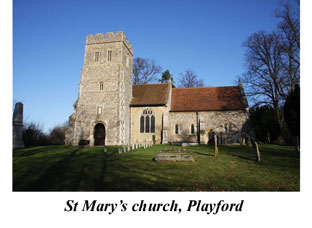 doorway
of c.1300 and a chancel arch from c.1370. The nicely traceried perpendicular
south and west windows are a later addition. The south porch-tower, one
of only twenty-two in Suffolk, was built by the generosity of Sir George
Felbrigge (Esquire at Arms to Edward III) and Margery (d. 1409) his second
wife, who left 5 marks for its "making". A canopied niche contains
a modern figure of Mary while the two medieval bells are most probably
contemporary with the tower. In 1859 the singing gallery was taken down
and the village musician who played the fiddle was replaced by a portable
hurdy-gurdy. A military brass of Sir George Felbrigge, one of the finest
in Suffolk, adorns the chancel. Deal box pews were removed from the nave
and a new trussed roof replaced a whitewashed barrel ceiling for Victoria's
Diamond Jubilee in 1897. Among the church's valued possessions are an
exquisite standing cup of 1619, willed by Lady Elizabeth Felton, and two
Charles I pewter flagons. The churchyard is approached through an imposing
lychgate and avenue of limes.
doorway
of c.1300 and a chancel arch from c.1370. The nicely traceried perpendicular
south and west windows are a later addition. The south porch-tower, one
of only twenty-two in Suffolk, was built by the generosity of Sir George
Felbrigge (Esquire at Arms to Edward III) and Margery (d. 1409) his second
wife, who left 5 marks for its "making". A canopied niche contains
a modern figure of Mary while the two medieval bells are most probably
contemporary with the tower. In 1859 the singing gallery was taken down
and the village musician who played the fiddle was replaced by a portable
hurdy-gurdy. A military brass of Sir George Felbrigge, one of the finest
in Suffolk, adorns the chancel. Deal box pews were removed from the nave
and a new trussed roof replaced a whitewashed barrel ceiling for Victoria's
Diamond Jubilee in 1897. Among the church's valued possessions are an
exquisite standing cup of 1619, willed by Lady Elizabeth Felton, and two
Charles I pewter flagons. The churchyard is approached through an imposing
lychgate and avenue of limes.
5.1.2 Buildings etc.
Great Bealings Seckford Hall was the seat of the Seckford family from the time of Edward I to Charles I. It was rebuilt in 1530 as a country residence by Thomas Seckford and described by Norman Scarfe as having the most romantic 16c façade in England. It was then rescued from decay in the late 1940s by Sir Ralph Harwood who turned it into a first class hotel.
Bealings House sits in splendid isolation and is a red brick mid Georgian building of seven bays with parapet and pitched roof. Its doorway has Ionic columns and pediment. The Lodge, listed Grade II, is essentially unchanged since 1849. Its origins are probably a farmhouse, of the 17th or 18th century. The Croft, a Victorian house, was lived in by Admiral Pelham Aldrich and The Old Rectory, with many distinguished occupants, is early Victorian and sits high overlooking the church.
Annesley House, originally mid Victorian, was partially demolished and rebuilt much larger for Colonel and Mrs Downing in 1912 to the designs of well known Suffolk architect Harold Hooper. The roadside gateway is a copy of Cardinal Wolsey's gateway in Ipswich.
The characteristic hump back bridge was built in 1841. The village has had at least two pubs, the Boot in Boot Street and the Live and let Live in Lower Street. It is thought that two windmills existed in Great Bealings during the 1800s.
Little Bealings Wills and documents from the 14th and 15th centuries show a prosperous village rejoicing in more settled times. It was an area of small farms (dairy and arable), woodland harvested for building and rivers and marshes used for fishing and reed gathering. We learn from a will of Dame Elizabeth Wyngfield that a watermill was then working in the village. There are still a few houses left in the village from earlier times, notably Home Farm and Grove Farmhouse in the Street. Manor House and The Grove, although much altered, date from Tudor times.
In 1901, The Grove Estate was sold upon the death of Mr Naunton-Waller and some parcels of land and dwellings became owner occupied. The village shop and cottage were bought by Mr Littleford who continued to run this business for the next thirty or so years. The higher expectations of those people coming into the village and the education of the village people saw the need for a Reading Room to be built in 1913 - now a private residence. A village hall was erected after World War I in Sandy Lane and provided a focus for the village - as did the public house The Admiral's Head. In 1938 the Angela Cobbold Hall in the Street was erected in memory of Angela Cobbold who did much charity work in the village. After her tragic death, her mother and brother gave the hall to the church to be used for religious education purposes. It has had many uses over the years, dances during World War II and a doctor's surgery. In the early 1950s the village hall was deemed too small and the land was sold. Later a new hall was built on the sand quarry site and serves both Great and Little Bealings. Land at the rear of the hall was made into a playing field which now houses the John Belstead Field. This was opened in the spring of 2008.
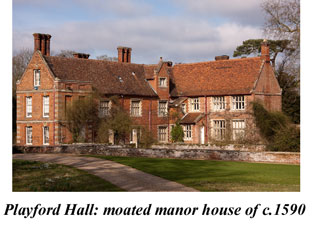 Playford
Playford Hall is a Grade II* moated Elizabethan manor house with contemporary
barn built by Sir Anthony Felton in c.1590. The east wing was demolished
in the early 18th century. Playford Mill, mentioned in Domesday Book,
ceased working in c.1874 when the 18th century buildings were converted
to farm cottages. With a population never exceeding 300 the village supported
few other trades: a smithy by The Brook survives only in 18th century
records; a brick kiln was still working in 1874; the last beer house was
demolished in 1892 and the last shop closed in 1998. Copyhold in Church
Lane is a vernacular house of the 15th or early 16th century. Two other
dwellings of possibly similar date were pulled down in the 1960s when
the village was redeveloped. The red brick cottages dotted around the
parish date from the 1880s when the Bristol Estate upgraded its housing
stock for agricultural labourers. The School, which had been housed in
a converted cottage at the top of Hill Farm Road built in 1816 out of
materials from the former barracks in Woodbridge Road, was closed in 1877
and transferred to Little Bealings. The Vicarage, of white Suffolk brick,
was built in 1845 for the curate at a time when the living was joined
with that of Rushmere. Playford Mount, a Grade II listed Gothic style
house, was built in 1867 by E C Hakewill (1816-72) for his own occupation.
Hakewill was one of the foremost church architects in Suffolk in Victorian
times. The village hall was built in 1896 and was extensively modernised
and enlarged in 2003. It was originally given by Mary Kate Stevenson who
was from a family of wealthy coal owners in County Durham and was the
wife of the Liberal MP
Playford
Playford Hall is a Grade II* moated Elizabethan manor house with contemporary
barn built by Sir Anthony Felton in c.1590. The east wing was demolished
in the early 18th century. Playford Mill, mentioned in Domesday Book,
ceased working in c.1874 when the 18th century buildings were converted
to farm cottages. With a population never exceeding 300 the village supported
few other trades: a smithy by The Brook survives only in 18th century
records; a brick kiln was still working in 1874; the last beer house was
demolished in 1892 and the last shop closed in 1998. Copyhold in Church
Lane is a vernacular house of the 15th or early 16th century. Two other
dwellings of possibly similar date were pulled down in the 1960s when
the village was redeveloped. The red brick cottages dotted around the
parish date from the 1880s when the Bristol Estate upgraded its housing
stock for agricultural labourers. The School, which had been housed in
a converted cottage at the top of Hill Farm Road built in 1816 out of
materials from the former barracks in Woodbridge Road, was closed in 1877
and transferred to Little Bealings. The Vicarage, of white Suffolk brick,
was built in 1845 for the curate at a time when the living was joined
with that of Rushmere. Playford Mount, a Grade II listed Gothic style
house, was built in 1867 by E C Hakewill (1816-72) for his own occupation.
Hakewill was one of the foremost church architects in Suffolk in Victorian
times. The village hall was built in 1896 and was extensively modernised
and enlarged in 2003. It was originally given by Mary Kate Stevenson who
was from a family of wealthy coal owners in County Durham and was the
wife of the Liberal MP
5.1.3 Roads and Railways etc.
Little Bealings The owners of The Grove were one of the major landowners and in 1859 the east coast railway line to Woodbridge and Lowestoft was built across this estate land. Until 1956 Little Bealings had its own railway station. This was closed as part of the 1950s rail closure programme, prior to the "Beeching Axe".
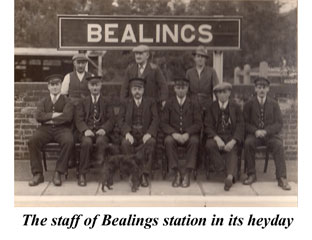 The
coming of the railway, with easier commuting, attracted wealthier people
to the area and larger houses were built in some parts of the village.
It remained, however, a very rural, agrarian society.
The
coming of the railway, with easier commuting, attracted wealthier people
to the area and larger houses were built in some parts of the village.
It remained, however, a very rural, agrarian society.
The 20th century brought radical changes to Little Bealings as elsewhere. The onset of developments in transport, higher expectations and two World Wars have shaped the village both literally and economically into what it is today.
Between the two World Wars much of the land of the southern perimeter of Little Bealings, which had been heathland and woodland, was developed for building substantial residential properties. Martlesham and Playford roads were transformed. Behind these houses much of the land was used for sand and gravel extraction.
Mechanical farming methods and the shortage of labour during and after the two World Wars swept away centuries of traditional farming methods and the social structure of the village. Farmhouses were sold as private homes, hedges ripped out to make way for farming on an almost industrial scale. Single trees stand in fields show the ancient hedgerow boundaries long gone.
Playford Three former hedged lanes have been all but lost. In 1708 Thomas Felton of Playford Hall 'inclosed to himself the common horseway' leading from The Brook to Rushmere Street, so diverting users to the less direct route to Ipswich that is used today; the track to Tuddenham over the Warren and that to Boot Street in Great Bealings from the top of Church Hill are both indicated on Hodskinson's 1783 map of Suffolk, the latter still in use around 1810 when Lord Bristol's carriage is recorded as being 'fearfully scratched'. The Ipswich to Lowestoft railway line, opened in 1859, cut through the centre of the parish in the river valley. The crossing gates on the Ipswich road were replaced by a bridge in 1871 leaving the former route still visible on the eastern side of the present approach.
5.1.4 Residents
 Men
from the villages fought in both world wars and each has a war memorial
near their church. In 1987, the area was severely affected by the great
storm with the villages virtually cut off and houses being without power
for up to 12 days. A great test of village community spirit!
Men
from the villages fought in both world wars and each has a war memorial
near their church. In 1987, the area was severely affected by the great
storm with the villages virtually cut off and houses being without power
for up to 12 days. A great test of village community spirit!
Great Bealings Admiral Pelham Aldrich, buried in the churchyard, was Admiral Superintendent of Portsmouth Docks and was also on several surveying expeditions around the world. Lord Hatherley, a former Lord Chancellor, is also buried in the churchyard.
Major Edward Moor bought Bealings House on his retirement from the army, in 1806. He had served in India, being wounded three times. He was a Fellow of the Royal Society and an author on Indian mythology. He constructed the stone folly to the front of the house reputed to contain his collection of heathen idols so that they might come to no harm. He also wrote the mystery, "Bealings Bells", in 1834.
The writer Lady Winifred Fortescue (nee Beech) was born in the Old Rectory in 1888 where her father was then rector of Great Bealings. In her autobiography "There's Rosemary There's Rue" she describes her early life in the village and the people who lived there.
More recently, the Old Rectory was home of the late Lord Belstead, who was a local farmer, but also Leader of the House of Lords, Northern Ireland minister, Lord Lieutenant of Suffolk and a major benefactor for the new sports field and playground. His grave is in the churchyard.
Little Bealings The Whites Directory of 1844 tells of a village of gentlefolk, tradespeople, shopkeepers and farmers, also a publican and a Dame School. The 1881 census lists occupations, apart from labourers, of workers in industries such as brickmaking, malting and coprolite extraction. Others were listed as shepherds, gamekeepers, thatchers, gardeners, a blacksmith, wheelwright, shopkeepers, postmaster, schoolteacher, stationmaster, signalmen, porters and farm bailiffs. The women and girls were employed as cooks, maids, domestic servants, laundresses and dressmakers - a very different situation from today. 19th century Little Bealings had small mixed farms, small holdings for vegetables, fruit and pig production as well as service occupations for the community. In response to the 1870 Education Act, Bealings school was opened in 1877, producing for the first time numerate and literate children. The village was almost self sufficient and people tended to stay put.
Little Bealings changed dramatically in the 1960s. Some very old cottages in the Street were demolished and land formally used as allotments in Sandy Lane was developed for housing. Richard's Drive and Michael's Mount came into being and greatly enlarged the population. In the early 1980s the village shop and Post Office closed, the school almost closed and the Admiral's Head had a makeover.
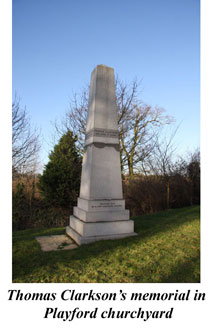 Playford
Thomas Clarkson (1760-1846), the slave trade abolitionist, lived at Playford
Hall from 1816 until his death and is buried in the churchyard. Insufficient
credit has been given to Clarkson for his life's work: it was he who initiated
the task, produced the necessary evidence and provided the momentum while
Wilberforce fought for the cause in Parliament.
Playford
Thomas Clarkson (1760-1846), the slave trade abolitionist, lived at Playford
Hall from 1816 until his death and is buried in the churchyard. Insufficient
credit has been given to Clarkson for his life's work: it was he who initiated
the task, produced the necessary evidence and provided the momentum while
Wilberforce fought for the cause in Parliament.
Sir George Biddell Airy (1801-92) was seventh Astronomer Royal from 1835 to 1881. Today he might also have been called Government Chief Scientist for among his many accomplishments was the establishment of the Greenwich Meridian in 1884. There are craters on Mars and the moon named after him.
Arthur Biddell (1783-1860) of Hill House, was a pre-eminent Suffolk farmer, an industrious land surveyor at the time of the tithe commutations and an inventor of agricultural machinery which was manufactured by his in-laws the Ransomes of Ipswich.
Francis Seymour Stevenson (1862-1938) of Playford Mount was Liberal MP for the Eye Division 1885-1906. His over enthusiasm for the construction of the Mid-Suffolk Light Railway to help his rural constituents during the agricultural depression caused both his own bankruptcy and that of the railway for which he had to resign his seat. In 1895 he became the first chairman of Playford Parish Council.
Today, our three villages are three thriving communities. The new Playford Parish Hall and the new Bealings playing field are testament to the efforts of many for the good of all of us who live here. In Little Bealings, the school and the pub are now flourishing and are excellent facilities for all three villages, which, though they have seen many, many changes over the hundreds of years people have settled this land, have retained the warmth of very welcoming and positive communities.
5.2 The Parishes Today
An idea of the size of the villages can be seen from the numbers of residents and households for each parish in the table below. The household figures were supplied by Suffolk Coastal District Council from their database at February 2006, whilst the figures for residents came from the Suffolk County Council estimates for mid 2005 . The figures from the 2001 Census are also given for comparison.
|
Parish |
Population |
Households |
||
|
|
SCC figures |
2001 Census |
SCDC figures |
2001 Census |
|
Great Bealings |
310 |
290 |
120 |
114 |
|
Little Bealings |
470 |
445 |
185 |
175 |
|
Playford |
220 |
204 |
90 |
88 |
The villages of Great Bealings, Little Bealings and Playford are tucked away between Ipswich and Woodbridge. They all enjoy a rural setting in the beautiful River Fynn and River Lark valleys with protected landscape areas, but provide easy access to the A12 and to the employment, shops, services and social facilities of Martlesham, Kesgrave, Ipswich and Woodbridge. Each retains its own church, individuality and character, but they also share many services, including the school, the pub and a bus service from Ipswich to Woodbridge that passes through all three villages. Car users have the option of using the Park and Ride in nearby Martlesham.
A mobile police station visits the villages regularly and is sited by the Angela Cobbold Memorial Hall in Little Bealings.
5.2.1 Great Bealings
The majority of the population of Great Bealings lives in two discrete hamlets - Boot Street and Lower Street. The housing in the parish was built mostly after the second World War and a large proportion of it consists of detached bungalows and houses set in reasonably sized plots. There are also many historic and architecturally fine dwellings and St Mary's church. Seckford Hall Hotel and Howard Construction provide some local employment but otherwise residents commute out of the parish, mostly to Ipswich and Woodbridge.
Following the recent closure of the post office and village shop there are no retail or similar fixed facilities or services within the parish.
5.2.2 Little Bealings
The two main residential areas of Little Bealings are in and around The Street and along the Playford and Martlesham Roads. The former Victorian railway station in The Street now enjoys a renaissance as the Mallard House Business Centre, offering some local employment. The Admiral's Head independent public house and restaurant is also located in The Street and is the only pub in the three parishes. Sandy Lane, off The Street, is a small community of mainly detached bungalows built in the 1960s and is also home to Bealings County Primary School.
In 2008 a school bus for pupils at Kesgrave High School was introduced.
All Saints church is served by the office and social facilities of the Angela Cobbold Memorial Hall. This Hall is also home to 1st Bealings Girl Guides. In addition, Bealings Village Hall provides a meeting place for the benefit of local residents. The Village Hall, like many of the local clubs, is shared between Great and Little Bealings, but located in Little Bealings. Local fund raising and the hard work of a Project Team now means that the new John Belstead Playing Field provides leisure and sports facilities for both Great and Little Bealings residents, including a wide variety of children's play equipment, a tennis court and a boules area.
Bealings Bowls Club enjoys its own home in The Street and attracts players from outside the villages. The Club plays in four leagues between April and September.
Bealings Village Hall
A variety of clubs and societies, both from within and outside the villages, meet regularly at the Bealings Village Hall. These include the Bealings Women's Institute which meets at the Village Hall eleven times a year, often with a pre-meeting lunch. Bealings Carpet Bowls Club also meets in the Village Hall regularly, with an enthusiastic membership playing in a Summer League and other competitions. Bealings Badminton Club moved from the School to the Village Hall when the Hall opened in 1957 and continues to be popular. The club meets on Thursday evenings from September until April. Other activities, such as keep fit, country dancing, drama and art classes also take place at the Hall. The Hall has a Snooker Room and a Committee Room, where Great and Little Bealings Parish Councils hold their meetings.
5.2.3 Playford
In terms of population, Playford is the smallest of the three villages with most of the houses clustered between St Mary's church and the Parish Hall.
The excellent and very well used Parish Hall provides art classes, a playgroup, bridge club, weekly yoga and monthly whist drives and hosts the annual Harvest Supper. Playford Women's Institute meets there on the first Tuesday of every month. The Parish Hall committee promotes community with, for example, Pub Nights, a summer Family Barbecue and a regular film for children in the run-up to Christmas. On the field outside there is a children's play area, a small football pitch and a boules piste. For other facilities, residents visit Bealings Village Hall and Playing Field.
5.2.4 All parishes
Mobile Library
Orwell Mobile Library 2 visits the three villages on alternate Tuesdays as shown below:
|
Playford: Telephone kiosk |
12.25pm - 12.40pm |
|
Great Bealings: Boot Street |
12.50pm - 1.05pm |
|
Great Bealings: Lower Road |
1.10pm - 1.25pm |
|
Little Bealings: Admiral's Head |
1.35pm - 2.00pm |
The Benefice Newsletter
Great and Little Bealings were joined by Playford and Culpho to form a single benefice in 1971 and a newsletter was developed as an information link for the new relationship. Although published by the Benefice, it has developed a far wider remit, carrying information and items of interest to all four parishes. In 2006 it was agreed that increased funding from the Parish Councils would enable it to be delivered free to every household. It still relies on volunteers to produce and distribute it, but is a very important means of sharing information throughout the parishes.